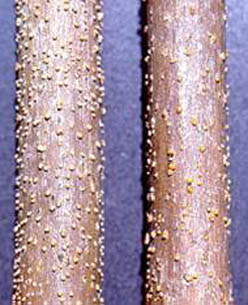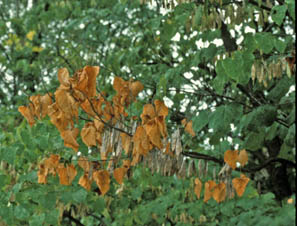Fall Canker Cleanup | |
|---|---|
| September 18, 2008 | |
|
Now is a good time to evaluate your trees for removal of dead or cankered wood. Stressed wood distinctly stands out now because any foliage that is present is showing slightly premature fall color in contrast to the green foliage of healthy areas, as seen on this redbud tree. Cankers are dead areas on a branch or stem. They may be sunken, bumpy, offcolor, or even wet or water-soaked. The wood is dead under the bark of a cankered area. Branches that have been infected by opportunistic fungi often exhibit these cankers. Remove dead or cankered wood now while it is easy to find and while the tree is hardening off for winter. The goal is to prevent wood rot fungi from entering the dead wood and moving into larger branches or trunk tissue. The fungi that are found in cankers are usually known as stress pathogens. They do not harm the tree or shrub until the plant is stressed. Canker fungi have been shown to be present in some trees without causing a problem until the tree is stressed. Remove dead wood (now) and try to identify and correct the source of stress. Some stress factors might include water imbalance, root compaction, root injury, chemical damage, girdling roots, trunk damage, or root rot. Some of these problems can be corrected while other may not be helped. Fruiting bodies in the cankered area help us (in the lab) identify the fungus involved. The image shows fruiting bodies of Tubercularia on the face of an oak canker.  The oak branch sections in this image are bumpy due to the fruiting bodies of the Tubercularia fungus popping through the bark. The threatlike mycelium of the fungus is inside the bark or wood. To get all of the infected tissue, including the mycelium that may not be as obvious, remove a few inches of wood beyond the cankered wood into the healthy tissue. The internal wood that remains should be white, tan, or green. For more information on cankers and wood rots of trees, visit the Extension Vista Web site at http://www.ag.uiuc.edu/%7Evista/horticul.htm and scroll down to Report on Plant Disease, no. 636, “Canker and Dieback Diseases of Woody Plants,” and no. 642, “Wood Rots and Decays.” | |
| Author: | Nancy Pataky |

